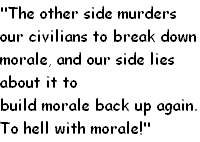Murray Leinster's "Morale: A Story of the War of 1941-43" (novelette, superweapon, free): There are multiple ways of defining terrorism

There are two major themes here:
- A version of state terrorism: During war, at least one side uses outright terrorizing of civilian population of the opponent as a matter of war strategy. That's how the story gets its title - enemy's all out effort to break the morale of local civilian population. Because this is a pre nuclear weapons story, form of terror is cruder than Hiroshima.
- In an otherwise equal battle, one side introduces a superweapon to completely change the war situation - in the tradition of H G Wells' "The Land Ironclads", & Robert Heinlein's "Solution Unsatisfactory".
Story summary.
US is fighting a war against an unnamed enemy, primarily along the Pacific coast. There is very minor military deployment along east coast, & primarily to tell civilian population that east is also being defended.That's when a very tiny enemy contingent lands "in New Jersey Aug. 16, 1942" with their superweapon: a single massive supertank called "Wabbly" - "two hundred feet long" with "eight-foot-wide steel treads". It is equipped with induction weapons in a "dinkus on top" & poison gas weapons. It is supported by an unspecified number (but apparently very few) high flying supersonic aircraft capable of precision bombing. Any US aircraft attacking invading aircraft are destroyed by tank's induction weapon; any attack on Wabbly is neutralized by invading aircraft which can remotely sense "sparks from a motor", & use this information for precision bombing. Normal infantry attack on Wabbly is hopeless.
Wabbly will unleash a rein of absolute terror in many cities, completely leveling whole cities & villages killing every human in the path. Nothing the defenders have can touch Wabbly. Until the two heroes - Sergeant Walpole & Flight Cadet Ryerson - figure out a deception that will make the invading aircraft attack their own Wabbly!
See also.
- Two other stories that make use of induction weapons: Larry Niven's "The Warriors", & Murray Leinster's "Proxima Centauri".
Fact sheet.
First published: Astounding Stories, December 1931.Download full text from Project Gutenberg.
Download audio from Maria Lectrix, in two parts: 01 & 02. Or direct MP3 at Internet Archive - 01 & 02.
Rating: A
Related: Stories of Murray Leinster.

0 comments:
Post a Comment